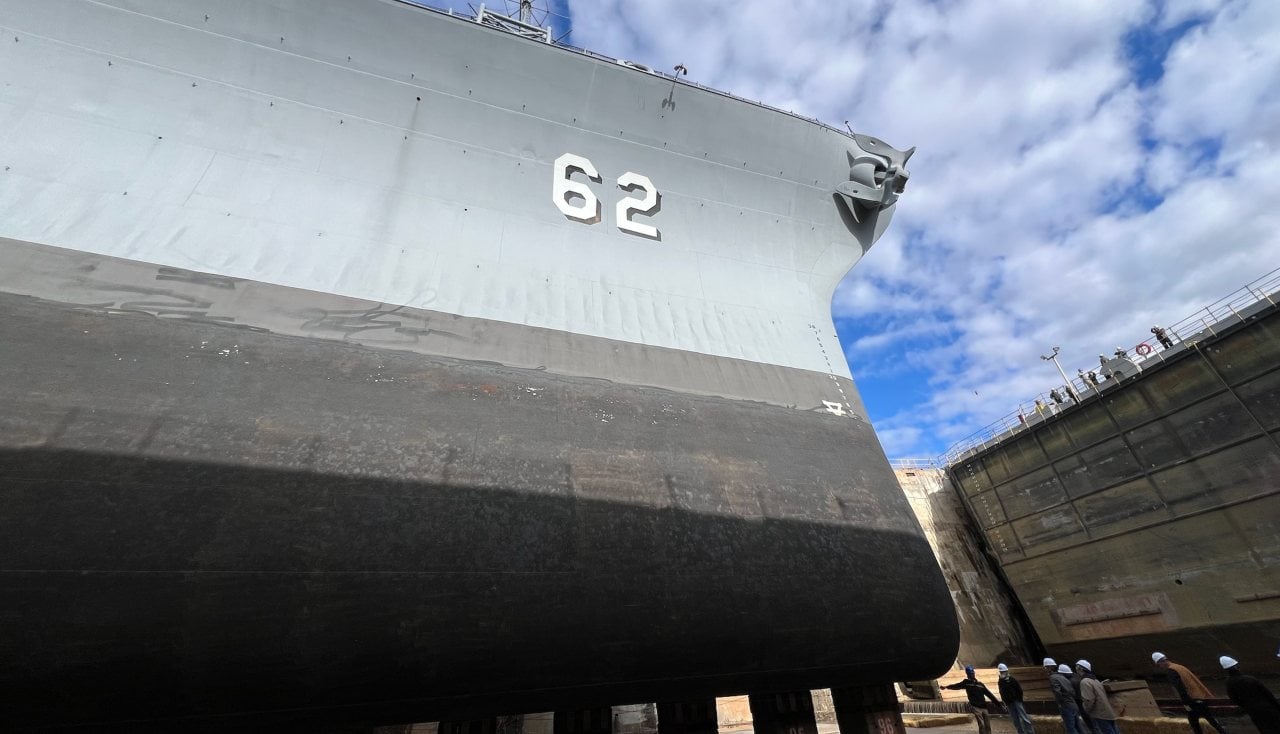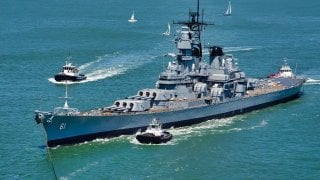The Iowa-Class Battleships are a Nightmare for the U.S. Navy for One Reason
The Iowa-class battleships, designed during the Interwar Years, symbolize a bygone era of U.S. naval dominance and strategic foresight, tailored specifically to combat the then-imminent threat from the Japanese Empire. They showcase today, in many respects, how the U.S. navy could be in decline.
Summary: The Iowa-class battleships, designed during the Interwar Years, symbolize a bygone era of U.S. naval dominance and strategic foresight, tailored specifically to combat the then-imminent threat from the Japanese Empire.
-These battleships, which were the last of their kind produced by the United States, were envisioned to dominate naval battles. However, their actual combat roles during World War II predominantly involved providing artillery support rather than engaging enemy battleships directly.
-Post-war, these formidable vessels transitioned into museum ships, still held in reserve until formally deemed unnecessary with the advent of the Zumwalt-class destroyers, which were initially expected to surpass the capabilities of the Iowa-class. Reflecting on the Iowa-class not only underscores changes in military technology but also highlights a shift in strategic planning from designing for defined current threats to preparing for uncertain future warfare, a shift that has influenced contemporary defense procurement and strategy.
The Iowa-Class Battleships: Understanding America's Naval History and Its Implications for Modern Warfare
Designed during the Interwar Years, when bigger was better and the battleship was the baddest boat on deep blue sea, the Iowa-class battleship was in a class of its own. And, according to the makers of the Hasbro game, Battleship, in the 2013 flop of the same name, the Iowa-class is capable of destroying alien warships.
But let’s keep our focus on the more terrestrial threats these steel behemoths both were designed to fight and actually went up against.
Because the Age of the Battleships ended far sooner than anyone expected, the world never really got to see that magnificent naval battle for dominance that the Iowa-class was designed to fight—and win.
Instead, these battle wagons, after Pearl Harbor occurred and America found itself thrown into the Second World War, ended up being used as giant artillery trucks to give cover to US ground forces.
They did fight in some naval engagements, too. Although, these battle wagons, sadly, never faced a rival Japanese battleship in the war.
In fact, of the two battleship-on-battleship fights that US warships partook in against the Imperial Japanese Navy, the US battleships in those battles were not of the fabled Iowa-class. After that war, the battleship began its slide into obsolescence. It never really did perform the functions it was originally designed to do.
Such is the nature of modern warfare, though. There are plenty of systems even today that end up performing far different roles than they were at first intended to perform to meet real-world needs of the force.
The U.S. Navy Used to Build Relevant Warships That Lasted
Interestingly, the Iowa-class were the last class of battleships the United States ever produced before the aircraft carrier became the belle of the Navy’s ball.
These steel beasts were designed to both dish out—and take—quite a wallop. Just look at the specs of these gray battle babes. The Navy equipped her with nine 16-inch guns, split between two turrets in the front and back of the boat. These could launch a 2,700-pound shell across a range of 26 miles.
As a point of reference (and to show you how far America has fallen from its glory days of being the “arsenal of democracy”), the Navy doesn’t even produce or still retain any of the ammunition for the 16-inch or 14-inch guns that make up the armaments of the Iowa-class battleship.
The very interesting aspect about the Iowa-class and pretty much the entire US Navy fleet back in the 1930s and 40s was their warships were not designed to fight “the wars of the future today” as so many defense contractors today gush about their newfangled platforms (which are almost always not worth their exorbitant cost).
Instead, reflecting a practicality and prudence that the United States has lost since the end of World War II, the battleship was only designed with one, near-term, near-peer rival in mind: the Japanese Empire. The Navy wasn’t trying to imagine what war in 1980 would look like, as defense planners today try to design systems to fight wars 40 years from now.
That’s probably why the Iowa-class battleships sailed the High Seas for the closing half of the twentieth century and are now, in the twenty-first century, well-maintained museum ships.
In fact, the United States Congress embedded a secret order within the National Defense Authorization Act of 1996 instructing the US Navy to keep “at least four” of the Iowa-class battleships in working order and to maintain the logistical base for these legendary warships, just in case they were needed in the future (the Iowas were pulled out of retirement at least twice in their long service to the country) or until the Secretary of the Navy certified that these warships were no longer needed.
A decade after that congressional directive was passed in the 1996 National Defense Reauthorization Act, the George W. Bush Administration certified that these battleships were no longer needed as the new Zumwalt-class destroyers, which were futuristic-looking stealth destroyers that were to be armed with potent cannons, would meet—and eventually surpass—the capabilities of the Iowa-class battleships.
A few short years after that decision was made, the Zumwalts were recognized as the abject failures that many analysts suspected they would be.
The Navy's Battleships Aren’t Coming Back But the America That Built Them Needs To
Certainly, the Age of the Battleship has been long over. It isn’t likely to come back. Yet, as America’s defense industrial base must basically start from zero today, it is important to understand the assumptions and worldview that dominated the minds of both the designers of the Iowa-class battleships as well as the rest of the US Navy’s fleet in the 1930s and 40s.

The fleet that defeated the Axis Powers at sea and paved the way for the United States to become the global hegemon.
America has lost something that many had taken for granted. It shows in the way that the US military procures platforms, such as its warships. Designers today are obsessed with waging tomorrow’s wars, yet they rarely deliver the systems needed to fight today or the next day.
About the Author
Brandon J. Weichert, a National Interest national security analyst, is a former Congressional staffer and geopolitical analyst who is a contributor at The Washington Times, the Asia Times, and The-Pipeline. He is the author of Winning Space: How America Remains a Superpower, Biohacked: China’s Race to Control Life, and The Shadow War: Iran’s Quest for Supremacy. His next book, A Disaster of Our Own Making: How the West Lost Ukraine, is due October 22 from Encounter Books. Weichert can be followed via Twitter @WeTheBrandon.
The main Image is Creative Commons. Intext image is courtesy of Ethan Saunders.


